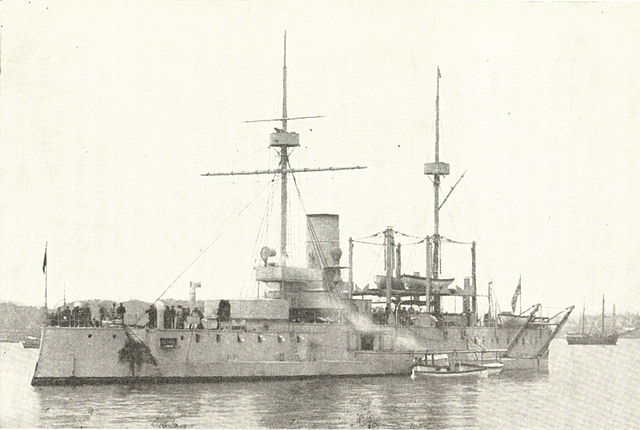
Development
Denmark saw a decline of naval rank after the devastating Battle of Copenhagen and by the 1880s was essentually a minor coastal defense force, focusing of deterrence against its neighbor, starting with Imperial Germany, fuelled by its conflicting past with Prussia. In the decade after 1860, Denmark purchased or built eight ironclad warships, coastal defense ships and scrapped its fleet of wooden steam frigates in order to face a possible new conflict with what was now the German Empire. These coastal vessels were part of an integrated coastal defense system based around the island of Zealand, and surrounding shore forts protecting Copenhagen Bay. It was completed by spar torpedo boats to attack by night a blockading fleet, coastal artillery, and mines. In 1880 she fleet had still the old broadside ironclads Dannebrog, Peder Skram, Danmark, and the armoured coast defence ships Rolf Krake, Lindormen, Gorm, and Odin.
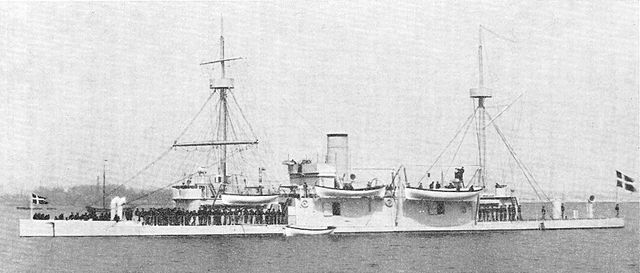
HDMS Odin, Helgoland’s predecessor.
It is important to look at these ships in regard to previous coastal battleships fielded by Denmark. From Rolfe Krake in 1863 to Gorm in 1870 (launched date), these were all low freeboard monitors with 9 inches and then 10 inches main guns, both inside a single Coles Type turret. The latter offered almost a 360° arc of fire. Protection went from 5 inches to 7 inches with a 8 inches turret on HDMS Gorm (1870). Albeit for HDMS Odin, Denmark choose to drop the turret and get back to a central citadel for four 10-inches RML. This was to focus on a better armopur, and the realization there was a limited what a Coles turret could carry as ordnance. It was seen as slow for 1870s standards.
HDMS Oden’s four single Armstrong 254 mm (10 in) rifled muzzle-loading (RML) guns were in an arguably better protected armored citadel and it was easier to just move around the ship to present either broadside than to wait for the turret the correct bearing, especially if the latter could not be armoured more than 5.5 inches. She also received six 76 mm (3.0 in) guns to deal with closer targets, notably spar torpedo boats. But this was later revised in 1883 for modern Krupp guns with a better arc of fire. Meanwhile as the ship was already launched in 1872, the Danish staff worked on a successor design.
Indeed, all these monitors were only intended to serve close to the shores, and due to their low freeboard, they had little options outside these waters, notably out in the Baltic or worse, in the north sea. This lack of flexibility for longer range operations and expeditions in alliance (like with Austria) was seen as a problem. In the early 1870s, the Navy’s artillery support needs led to the acquisition of five small unarmored gunboats but this was not satisfactory and a budget constraint. Politician and naval officer N.F. Ravn became marine minister in 1873 and he worked for a better design that could be used outside Danish waters, both in the North sea and Baltic and potentially cover a landing.
In 1875 he succeeded in getting plans for such a ship, and they were approved by the parliament. This was a feat only possible by his good political links as this ship was significantly larger than all previous Danish armored ships, reaching 5330t as calculated. Indeed over 5,000 t these were considered “battleships” and no longer assimilated to coastal defence. This was bold move and gave Denmark in effect its first true sea all-steam going battleship ever. It remained the country’s only battleship however.
Heligoland as she was named was also desifned as the first Danish armored ship armed with breechloading cannons, and torpedoes as well. It resulted from debates about just how about these new heavy guns could most appropriately mounted. Some looked at Britain and saw this split between central battery and turrets ships, while France went for semi-open turrets (barbettes), combined with a central battery. The Danish design department wanted four guns, and agreed to place them in a central battery casemate as on Odin, but combined with a gun turret on the foredeck. The latter gun for of 30.5 cm gun, the thus became the Danish Navy’s most powerful ordnance to date, manned by eight men.
HDMS Heligoland was laid down completed at Copenhagen Royal Yard on 20 may 1876, launched on 9 May 1878 and completed by late 1879. Since this became Denmark’s prestige capital ship, she was provided with extra cabins and a large, lavishly decorated salon, to work as an admiral’s flagship for naval squadrons. She was also intended to show the flag aboard.
Design of the class
Hull and general design
HDMS Heligoland had a fixed spur ram forward (unlike Odin, whuch had a unusual withdrawable spur ram) and a greater draught than her precedessor. The hull was still wide, whereas it was much longer, at 79.17 m (259 ft 9 in) long overall for a beam of 18.05 m (59 ft 3 in) and a draft of 5.9 m (19 ft 4 in) – versus 240 x 48 x 16 ft (73 x 14.7 x 5 m). The greater beam gave her extra stability, in addition to the very design, because despite she had a taller hull, the main freeboard was much lower and similar to the previous Odin. The central raised hull created an almost rectangular section, with the rounded bow and pointed prow at both extremities. She displaced 5480 tonnes of 5,393 long tons, versus 3170 tonnes of Odin, so quite an increase. She also had to masts and a small bridge but no conning tower, she was added later in a refit.
Protection
Helogland had a complete waterline belt (see below) in wrought iron. The barbette and side of the armored citadel were also well protected, and the deck armor wad flat. HDMS Helgoland had a Belt 152–315 mm (6.0–12.4 in) in thickness depending on the location. The greatest thickness was under the casemate, fully protecting the 10 inches guns ammunition supply wells down the waterline. The Casemate itself had walls 260 mm (10.2 in) thick. The belt was thinned down fore and aft to the bow and stern. The main gun Barbette was inspired by French turrets, yet covered and with 260 mm (10.2 in) thick walls. The armoured deck, protecting the machinery and steering was 52 mm (2 in) thick.
A conning tower was added later. It was protected by walls 33-millimeter (1.3 in) thick.
Powerplant
She came with two shafts, driven by two HRCR engines or Horizontal Reciprocating Compound-expansion steam engines, fed by 8 cylindrical boilers for 4,000 ihp (3,000 kW) and a top speed of 13.7 knots on speed trials, or 13 knots as designed (24 km/h; 15 mph). For autonomy she carried 224t of coal for an endurance of 1,050 nautical miles at 10 knots or 1,400 nmi (2,600 km; 1,600 mi) at 9 knots (17 km/h; 10 mph) dependong on their coal load and sources.
Armament
She was completed with an extremely powerful armament of a single 30,5 cm L/22 RML ub turret forward, and four 26 cm L/22 guns in the casemates amidships. There were also five 12 cm RML guns located admiships and aft plus one at the poop. This was completed after entering service by two 37 mm Hotchkiss revolver canons.
In 1886 this armament was revised as she had her poop 12 cm gun removed. In 1887 two 57 mm (6 pdr) quick-firing guns were added to deal with torpedo boats and the 37 mm revolver guns were replaced by 10 mm Nordenfelt machine guns. In 1893 there was a last an largest refit. The 10 mm Nordenfelt machine guns were replaced by 8 mm Maxim machine guns and torpedo tubes were added, two 38 cm in the bow, fixed. She also carried towed torpedoes for 1888 (brough by her on board steamers) and two traversing 35 cm torpedo tubes were later added.
Krupp 305mm/19 RK L/22 C/78 (12 inches)
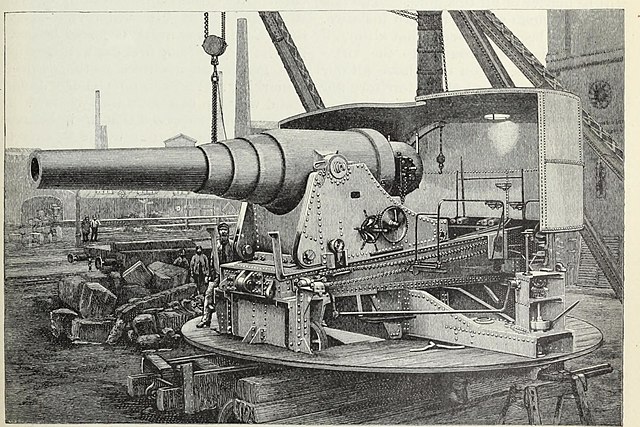
The 30.5 cm Mantel Ring Kanone L/22 was a 30.5 cm 22 caliber long Krupp Mantel Ring Kanone, rifled breech loader and built-up gun. It had the Krupp cylindroprismatic sliding breech and was developed from the 30.5 cm RK L/22 exhibited at the 1873 Vienna World’s Fair. It could traverse at 240° in six minutes and 40 seconds and the rate of fire was of five minutes. This was quite slow, but at least the four 26 cm guns could fire a shot every four minutes, but they had a range down to 5.5 km compared to 6.4 km or the 12 inches.
It had a Mass of 35,6 tons, a length of 6,700 mm and a muzzle velocity of 510.6 m/s.
Krupp 263mm/19 RK L/22 C/76 (10.2 inches)

These were the precessors of the Krupp 263 mm (10.2 in) 35-caliber guns C/86 mounted on the next HDMS Iver Hitfeldt. This casemate gun had a mass of 22 tons, a length of 5,720 mm for the L/22 and exact caliber of 262.5 mm with a horizontal sliding wedge breech and a muzzle velocity of 490 m/s. They were placed behind gin ports in the armoured casemate, and sat relatively low over the water, which the outer hull compensated a bit to avoid water spray. Thei were installed on a set of three rails in a crescent setup in order to fire up to at a 90° angle, extended by 15° inwards on either beam.
Krupp 120mm/25 RK L/25 C/79 (4.7 inches)
No data so far. It is perhaps related to the 12 cm Lang staal, a Krupp designed field gun purchased by the Dutch Netherlands Army. The next Iver Hvitfeldt used the longer range 120 mm (4.7 in) RK 30-caliber guns. Its Range was 7,900 m (25,900 ft), 1.5 minutes rpm.
Torpedoes and light guns
Initially Helgoland had ten 1-podr revolver guns (37 mm). From 1887, defenses against torpedo boats had them replaed by fast-firing 57 mm (6 pounder) guns. The two small revolver cannons and later machine guns were placed in separate tops on the two military masts, with an excellent plunging fire and arc, view all around.
⚙ Helgoland specifications |
|
| Displacement | 5,480 t (5,393 long tons) |
| Dimensions | 79.17 x 18.05 x 5.9 m (259 ft 9 in x 59 ft 3 in x 19 ft 4 in) |
| Propulsion | 2 shafts, 2 compound-expansion steam engines, 8 cyl. boilers: 4,000 ihp (3,000 kW) |
| Speed | 13 knots (24 km/h; 15 mph) |
| Range | 1,400 nmi (2,600 km; 1,600 mi) at 9 knots (17 km/h; 10 mph) |
| Armament | 1× 305 mm L/22, 4× 260 mm, 5× 120 mm guns |
| Protection | Belt 152–315 mm, Barbette 260 mm, Casemate 260 mm, Deck 52 mm |
| Crew | 350 |
Career of Helgoland

Herligoalnd emerged from Orlogsværftets, København yard in 1879 as she was worked out, made her shakedown cruise and initial training. While on a trial run she was integrated in anticipation into that year’s squadron. She trained with Oden, Gorm and Lindormen. In the following years, she was fully crewed for annual exercise in squadrons, for the years 1881, 1884, 1885 and 1888. The rest of time she was kept in reserve as economic measure. She also called for foreign ports, like her first cruise to Leith in Scotland in 1891. In 1894 she led the Danish squadron to Rotterdam. In 1896-1897, she was inspected at Orlogsværftet and upgrade. She still took part in squadron exercises by 1897.
But she also left the squadron to represent Denmark at the naval review in Spithead for occasion of Queen Victoria’s 60th jubilee. The entire squadron visited Stockholm also in September 1897 to for King Oscar II’s 25th jubilee. Heligoland took part in squadron exrcises in 1900, this time visiting Oslo, but also 1902 including a visit to Karlskrona, and in 1904, with an illustrious commander on board, Prince Valdemar. It was decided after this last deployment to end her active service. She was decommissioned and then sold for BU that same year and then towed to the Netherlands for scrapping.
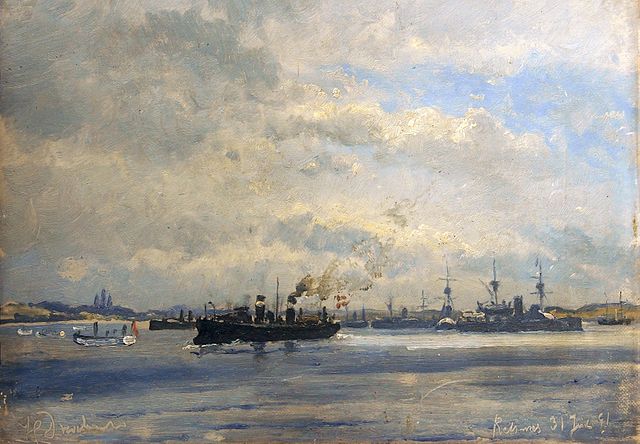
Read More/Src
Books
J. Gardiner, Conway’s all the world’s fighting ships 1865-1905
Links
navypedia.org
wiki HDMS_Helgoland
navalhistory.dk/ Helgoland1879.htm
Videos
None
Model Kits
Nothing
3D
Nothing

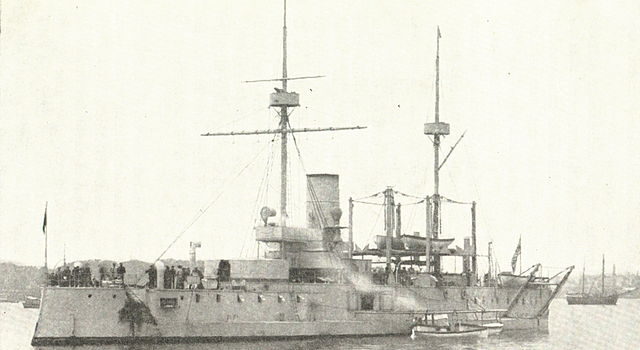

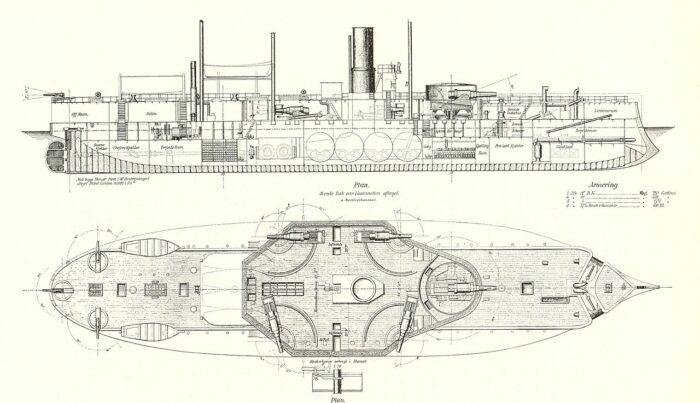
 Latest Facebook Entry -
Latest Facebook Entry -  X(Tweeter) Naval Encyclopedia's deck archive
X(Tweeter) Naval Encyclopedia's deck archive Instagram (@navalencyc)
Instagram (@navalencyc)





 French Navy
French Navy Royal Navy
Royal Navy Russian Navy
Russian Navy Armada Espanola
Armada Espanola Austrian Navy
Austrian Navy K.u.K. Kriegsmarine
K.u.K. Kriegsmarine Dansk Marine
Dansk Marine Nautiko Hellenon
Nautiko Hellenon Koninklije Marine 1870
Koninklije Marine 1870 Marinha do Brasil
Marinha do Brasil Osmanlı Donanması
Osmanlı Donanması Marina Do Peru
Marina Do Peru Marinha do Portugal
Marinha do Portugal Regia Marina 1870
Regia Marina 1870 Nihhon Kaigun 1870
Nihhon Kaigun 1870 Preußische Marine 1870
Preußische Marine 1870 Russkiy Flot 1870
Russkiy Flot 1870 Svenska marinen
Svenska marinen Søværnet
Søværnet Union Navy
Union Navy Confederate Navy
Confederate Navy Armada de Argentina
Armada de Argentina Imperial Chinese Navy
Imperial Chinese Navy Marinha do Portugal
Marinha do Portugal Mexico
Mexico Kaiserliche Marine
Kaiserliche Marine 1898 US Navy
1898 US Navy Sovietskiy Flot
Sovietskiy Flot Royal Canadian Navy
Royal Canadian Navy Royal Australian Navy
Royal Australian Navy RNZN Fleet
RNZN Fleet Chinese Navy 1937
Chinese Navy 1937 Kriegsmarine
Kriegsmarine Chilean Navy
Chilean Navy Danish Navy
Danish Navy Finnish Navy
Finnish Navy Hellenic Navy
Hellenic Navy Polish Navy
Polish Navy Romanian Navy
Romanian Navy Turkish Navy
Turkish Navy Royal Yugoslav Navy
Royal Yugoslav Navy Royal Thai Navy
Royal Thai Navy Minor Navies
Minor Navies Albania
Albania Austria
Austria Belgium
Belgium Columbia
Columbia Costa Rica
Costa Rica Cuba
Cuba Czechoslovakia
Czechoslovakia Dominican Republic
Dominican Republic Haiti
Haiti Hungary
Hungary Honduras
Honduras Estonia
Estonia Iceland
Iceland Eire
Eire Equador
Equador Iran
Iran Iraq
Iraq Latvia
Latvia Liberia
Liberia Lithuania
Lithuania Mandchukuo
Mandchukuo Morocco
Morocco Nicaragua
Nicaragua Persia
Persia San Salvador
San Salvador Sarawak
Sarawak Uruguay
Uruguay Venezuela
Venezuela Zanzibar
Zanzibar Warsaw Pact Navies
Warsaw Pact Navies Bulgaria
Bulgaria Hungary
Hungary

 Bundesmarine
Bundesmarine Dutch Navy
Dutch Navy Hellenic Navy
Hellenic Navy Marina Militare
Marina Militare Yugoslav Navy
Yugoslav Navy Chinese Navy
Chinese Navy Indian Navy
Indian Navy Indonesian Navy
Indonesian Navy JMSDF
JMSDF North Korean Navy
North Korean Navy Pakistani Navy
Pakistani Navy Philippines Navy
Philippines Navy ROKN
ROKN Rep. of Singapore Navy
Rep. of Singapore Navy Taiwanese Navy
Taiwanese Navy IDF Navy
IDF Navy Saudi Navy
Saudi Navy Royal New Zealand Navy
Royal New Zealand Navy Egyptian Navy
Egyptian Navy South African Navy
South African Navy






























 Ukrainian Navy
Ukrainian Navy dbodesign
dbodesign